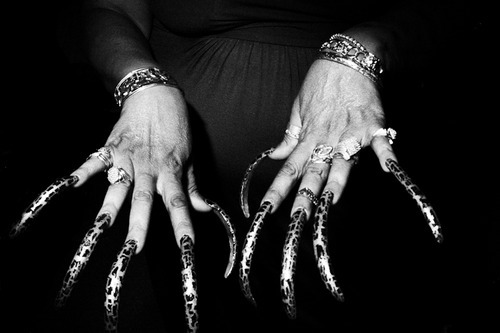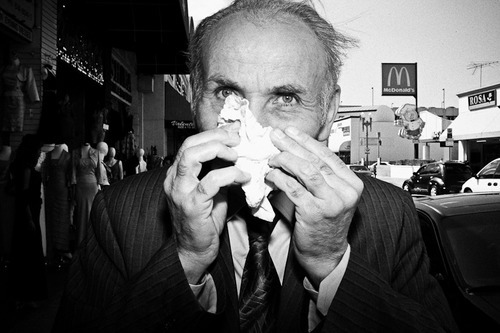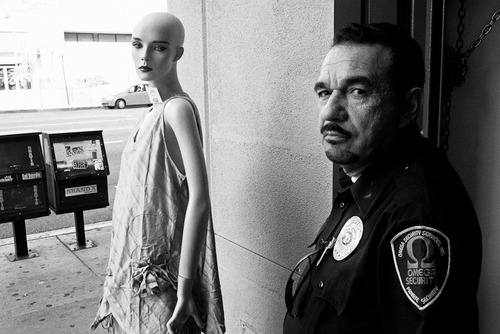Guest post by Eric Kim

I first got introduced to photography when I was 18 years old. At my high school graduation ceremony, my mom gave me a little Canon Powershot point-and-shoot. I never considered photography before in my life, but I was amazed by the power I now held in my hands.
I had the power to capture life around me — to photograph those fleeting moments and make them eternal through my camera.
The first month I had my camera, I was a fanatic. I took about a thousand
photographs a day— of everything. I took photos of my friends, family, my food, my shoes, you name it. Yes, imagine Instagram (before the days of instagram).
Fast-forward 7 years later. I now shoot exclusively with film, and make a living teaching street photography workshops. Through those 7 years I learned a lot about myself through photography. But like everyone else, I have many regrets. If I was able to step into a time-machine and give my 18-year-old self some advice, here are some things I would tell him:
Don’t worry about the gear so much: stick with one camera and one lens and focus on photography
I think the happiest I ever was in photography was when I first started. My trusty little Canon powershot was with me wherever I went. It was small and portable — it fit easily into my pocket. It wasn’t cumbersome, and it certainly didn’t weigh me down. The camera was perfect for me, and I never made it an excuse for not being able to take good photos.
Then of course after getting more involved into photography, I discovered
photography forums, photo blogs, and Flickr. I saw all these great photos with shallow depth-of-field (I didn’t know what “bokeh” was at the time) and I was blown away. How could I re-create those types of images? Certainly not with my point-and-shoot.
So of course after doing some research, I discovered I needed a “DSLR”. I did some research, and bought my first used DSLR off Craigslist- a Canon 350d (Rebel XT). I was blown away by the image quality (especially the performance at high-ISOs). But the lens it came with didn’t give me that lovely bokeh I saw so much on the internet.
More research lead me into discovering I needed a “prime” lens. I then went out and bought a Canon 50mm f/1.8. Of course like everyone out there, I shot everything at f/1.8. Everything.
It soon got quite boring, shooting everything at f/1.8. I felt bored by photography, and made the worst mistake— consulted the gear forums on online forums for some advice. The advice I was given? I needed more lenses to be more “creative”.
I was convinced I needed a wider prime lens, so I got a Canon 35mm f/2 (which is an incredible lens). I then wanted to look more “pro” as a photographer, so I bought a battery grip for my Canon 350d to make it look bigger. Of course, it was still far too small, so I got a Canon 70-200 f/4L lens (because only “noobs” got non-L lenses). I still wasn’t satisfied with my photography, so after looking at some great macro photography online I bought a Sigma 105mm Macro Lens (I used it only twice). I
was tired of carrying around all of these lenses, so I got a Sigma 18-200mm. I soon realized how crappy the performance of this lens was, and sold it. Then I got a 24mm f/2.8 as my 35mm f/2 didn’t feel wide enough on my crop sensor.
The fact that I worked in IT and spent a lot of time surfing the web didn’t help. I had tons of gear forums bookmarked in my browser, and would read these inane discussions about prime lenses vs zoom lenses, corner sharpness, chromatic abbreviation, distortion, and how sharp one could take photos of brick walls.
The more lenses and equipment I bought, the less I enjoyed photography. After much contemplation I thought I discovered the biggest issue to my photography: I didn’t have a full-frame camera.
I then rummaged the rest of my savings (and also dug into my student loans) and bought a Canon 5D (the original). Thus, I became a “real” photographer”.
I soon realized how much a pain in the ass this was. Whenever I went out to shoot, I carried a huge camera bag with all of my lenses. I could barely walk for half an hour before my shoulder started aching and my legs felt sore. I was a mess.
I then discovered this philosophy I read on the web called “one camera and one lens”. The proponent said that the best way to become more creative in your photography (and less addicted to G.A.S. — gear acquisition syndrome) was to stick to one camera and one lens for a year.
I thus stuck with my Canon 5D and my Canon 35mm f/2 for a year, and created the best work I have with my DSLR setup. Now I shoot with a film Leica MP, and still use a 35mm focal length when it comes to my work.
Here is what I learned from my “one camera and one lens” philosophy:
1. It eradicated G.A.S. from my system

G.A.S. (gear acquisition syndrome) is one of the worst diseases when it comes to photographers. It causes us photographers to make excuses about our gear - rather than going out and making photographs with what we have.
By prescribing to the “one camera and one lens” philosophy I got rid of most of the G.A.S. in my system. Sure, whenever a new camera or a new lens came out I got envious, but I still had an underlying philosophy to stick to.
2. It made me master a single focal length

In “Outliers”, the prolific writer/sociologist Malcom Gladwell suggested that the most talented people in the world dedicated at least 10,000 hours to their craft before gaining expertise in their field.
10,000 hours is a lot of time. Assuming you practiced something for 2 hours a day, it would take you 5,000 days to master something. 5,000 days is roughly 14 years of daily practice.
By constantly switching our equipment and gear, we never really get the time to truly know our camera and focal length. Assuming we are diligent enough as photographers to photograph for 2 hours a day, it would still take us 14 years to master our photography (with a given camera or lens).
Therefore by sticking with a certain camera or focal length for an extended period of time- it would help us gain mastery much quicker.
Of course digital cameras won’t last us 14 years, but sticking to a similar system and focal length is a good idea.
For example, about two years into my photography I decided that 35mm was my favorite/ideal focal length for how I saw the world. Since then, I have been shooting with only a 35mm lens (for about 5 years). In-fact, the 35mm f/2 Summicron is the only lens I own for my Leica.
Since I have been shooting with my 35mm lens for so long, I see the world in a 35mm focal length. I know exactly how close/far I need to be away from my subject to frame him/her the way I want to. I also know how a photo will look before I take it.
So if you have a DSLR, stick to a SLR system for an extended period of time. If you like rangefinders, stick to that. If you like compact cameras or mobile phones, that is fine too. I also suggest you to stick to one focal length as well.
3. It helped me be more creative

I believe when it comes to a “one camera and one lens” philosophy, the way to go is with prime lenses over zoom lenses. Why? Prime lenses force you to see the world in a certain way, and whenever the world doesn’t fit the way you exactly want to, you be more creative. Prime lenses also force you to use “foot zoom”, crouch, and experiment with compositions. Zoom lenses tend to make you lazy, as you can just
zoom in and out without making as much of an effort.
Sticking with one focal length forced me to be more creative when it came to my photography. If I wasn’t able to fit a subject in my frame at 35mm, I had to make due. Instead of doing a full-body shot of somebody, I might focus on their hands, their feet, or their facial expressions. If I was too far away from my subject, I would either try to incorporate the background more with my subject— or simply take a
few steps closer.
I highly recommend everyone to try the “one camera and one lens” challenge for a year. Of course if you are a working professional and you need multiple bodies and lenses for assignments, your case is different. This post is aimed for those of you who are hobbyists and shoot photography for fun, not a living.
What are your thoughts about the “one camera and one lens” philosophy? Share your thoughts in the comments below!